#psittaciformes
Text

Australian King Parrot (Alisterus scapularis), family Psittaculidae, order Psittaciformes, Macquarie Pass National Park, New South Wales, Australia
photograph by Jono Dashper (@jonodashperwildlife)
196 notes
·
View notes
Text

A nanday parakeet (Aratinga nenday) in Crescent Beach, Florida, USA
by Steve Raduns
#nanday parakeet#conures#parrots#birds#aratinga nenday#aratinga#psittacidae#psittaciformes#aves#chordata#wildlife: florida#wildlife: usa#wildlife: north america#introduced species
94 notes
·
View notes
Text

[2792/11080] Crimson rosella - Platycercus elegans
Order: Psittaciformes (parrots)
Superfamily: Psittacoidea (true parrots)
Family: Psittaculidae
Subfamily: Platycercinae
Photo credit: Julie Clark via Macaulay Library
#birds#Crimson rosella#Psittaciformes#Psittacoidea#Psittaculidae#Platycercinae#Platycercus#birds a to z#undescribed#25% - 50%
1K notes
·
View notes
Text

Day 18 of extinct birds - the Carolina parakeet or Carolina conure
The Carolina parakeet was one of only three species of parrot native to the US. They were very social birds, found in large flocks, and multiple females will lay eggs in a single nest. Interestingly, they were known to eat a lot of cocklebur seeds which are toxic (at least to mammals). Another interesting thing is that the last captive parakeet died in the same cage that the last passenger pigeon died, 4 years after.
#psittaciformes#bird of the day#bird art#birds#extinct animals#digital illustration#bird#daily art#ornithology#digital art
679 notes
·
View notes
Text



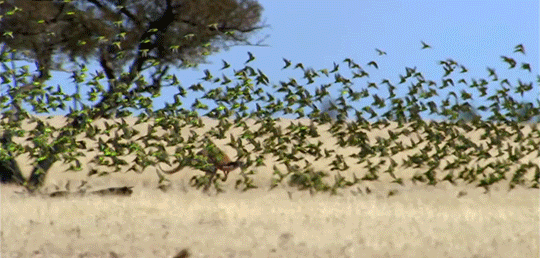

Wild budgerigars in the Australian outback
John Downer Productions
977 notes
·
View notes
Text

[ID: an illustration of a mottled green bird standing on a pink background and facing to the right. It has a branch with red berries in its mouth, and green leaves surround it. End.]
Kākāpō - a very endangered flightless parrot endemic to New Zealand. Kākāpō courtship revolves around a polygynous lek system, in which males gather to perform loud, deep booming songs in an attempt to attract a mate. Timelapse under the cut!
418 notes
·
View notes
Text

day 14
today's bird is pesquet's parrot (dracula parrot)!
request from @spikedpunkz !!
- pesquet's parrot is the only animal in its genus
- they feed almost exclusively on a few species of figs
- their faces are bald to prevent complications with feathers while eating fruit!
444 notes
·
View notes
Text

Blue-crowned Parakeet
#blue crowned parakeet#parakeet#Thectocercus acuticaudatus#Psittaciformes#Psittacidae#Arini#Thectocercus#bird#upl
227 notes
·
View notes
Text
If you've been following me for a while, you'll know I'm a sucker for stories about species reintroductions, rediscoveries, etc. And this one might be my favorite this year.
The kākāpō is this delightfully odd bird--a nocturnal, ground-dwelling parrot. Because New Zealand historically didn't have any predators apart from birds of prey, their camouflage was generally sufficient to protect them in the forest. Unfortunately, Europeans brought with them weasels, rats, and free-roaming cats, all of which hunted the kākāpō to the brink of extinction. Invasive species of deer additionally competed with the kākāpō for food.
By the 1980s, the birds had all but disappeared from the main island, and the world population bottomed out at 51 birds in 1995. Since then, breeding efforts and conservation on smaller, predator-free islands have brought the population back up to 252, but this is still a critically endangered species.
The reintroduction to the main island involved setting aside 3400 acres in which all mammalian predators had been eliminated. That would allow the kākāpō a safe place to breed and recover. Right now the four birds released into this sanctuary are all male, to allow conservationists a chance to observe them in this habitat. With time, though, we'll hopefully see females added as well, so that the population can begin expanding.
(By the way, yes--this is, in fact, the species in the infamous "shagged by a rare parrot" clip from the BBC's "Last Chance to See" series some years back. Don't worry, it's less NSFW than it sounds, and it is absolutely hilarious!)
#kākāpō#kakapo#parrots#birds#wildlife#nature#optimism#hopepunk#conservation#environment#environmentalism#endangered species#extinction#animals#ecology#restoration ecology#wildlife conservation#Psittaciformes#psittacines
567 notes
·
View notes
Text
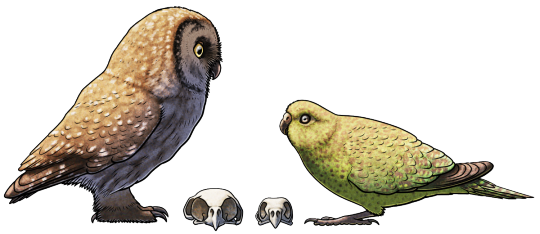
Strange Symmetries #23: Convergent Earvolution
Although it's not visible externally, owls have one of the most striking modern examples of asymmetry. The ears of many species are uneven, with the right ear opening positioned higher up than the left, giving them the ability to pinpoint the sounds of their prey much more accurately.
But surprisingly this isn't a unique anatomical trait that only ever evolved once in their common ancestor.
Instead, multiple different lineages of owls have actually convergently evolved wonky ears somewhere between four and seven separate times.
The boreal owl (Aegolius funereus), also known as Tengmalm's owl, is a small 25cm long (~10") true owl found across much of the northern parts of both Eurasia and North America. While most other owls' asymmetrical ear openings are formed just by soft tissue, the boreal owl's lopsided ears are actually visible in the bones of its skull.
But despite how many times owls have convergently evolved asymmetrical ears, and how successful this adaptation has been for them, for a long time it seemed to be something that no other animals have ever mimicked.
In the early 2000s asymmetric ears were reported in the skulls of some troodontid dinosaurs, which seem to have been nocturnal hearing-based hunters similar to owls, but proper details on this feature still haven't been formally published.
Then, just a couple of weeks ago, another example was finally announced.
The night parrot (Pezoporus occidentalis) is a small ground-dwelling parrot found in Australia, close to the same size as the boreal owl at around 22cm long (~9"). Critically endangered and very elusive, it's rarely seen and little is known about it – and it was presumed extinct for much of the 20th century, until more recent sightings of living individuals confirmed that the species is still hanging on.
Recent studies of preserved museum specimens have revealed that it seems to have poor night vision but excellent hearing, and that its right ear opening is noticeably asymmetrical, bulging out sideways from its skull. Much like owls the night parrot relies on acute directional hearing to navigate in darkness, but since its diet consists mainly of seeds it's probably not using this ability to locate food sources. Instead it may be listening out to keep track of the precise locations of other parrots, and for the approach of predators – so its sharp sense of hearing may be the reason this unique bird has so far just barely managed to survive the presence of invasive cats and foxes.
———
NixIllustration.com | Tumblr | Twitter | Patreon
#science illustration#not paleoart#boreal owl#tengmalm's owl#aegolius funereus#strigidae#strigiformes#owl#night parrot#pezoporus occidentalis#psittaculidae#psittaciformes#parrot#dinosaur#bird#modern dinosaurs#art#a superb owl#endangered species#convergent evolution#still seems to be an adaptation unique to birds and stem-birds tho
1K notes
·
View notes
Photo

Rosy-faced Lovebird / Peach-faced Lovebird (Agapornis roseicollis) - photo by Ken Behrens
1K notes
·
View notes
Note
Just wanted to say that your blog has brought me a ton of joy!
About a decade ago, I got to do an internship with the National Audubon Society near Constitution Marsh Sanctuary (in New York, right across from West Point), and seeing all of the bird pictures you post brings me back to that magical time. Thank you for sharing your passion with the world!!
Your'e welcome, and thank you as well.
Here's a favorite bird of mine for you...

Plum-headed Parakeet (Psittacula cyanocephala), male, family Psittaculidae, order Psittaciformes, Maharashtra, India
photograph by Dwipendra Chakraborty
283 notes
·
View notes
Text

A nanday parakeet (Aratinga nenday) feasts on a mango in the Pantanal, Brazil
by Isidro Vila Verde
#nanday parakeet#conures#parrots#birds#aratinga nenday#aratinga#psittacidae#psittaciformes#aves#chordata#wildlife: brazil#wildlife: south america
71 notes
·
View notes
Text
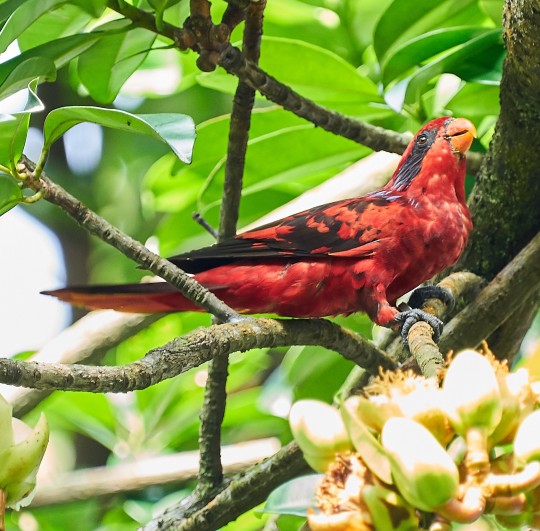
[1500/10977] Blue-streaked Lory - Eos reticulata
Order: Psittaciformes (parrots)
Superfamily: Psittacoidea (true parrots)
Family: Psittaculidae (Asian and Australasian parrots)
Subfamily: Loriinae
Photo credit: Steven Cheong via Macaulay Library
#birds#Blue-streaked Lory#Psittaciformes#Psittacoidea#Psittaculidae#Loriinae#Eos#birds a to z#undescribed
1K notes
·
View notes
Text

Day 17 of extinct birds - the Cuban macaw
Now that the pigeons are done (for now) it's time for parrots!
Humans were transporting Cuban macaws (and other parrots) between the Carribean islands likely beginning in prehistoric times! Once Europeans arrived, many Cuban macaw chicks were collected by felling trees that they nested in, which could have destroyed nesting habitat. Other threats included hurricanes and hunting. The last reliable sighting of the Cuban macaw was from 1864.
#psittaciformes#bird art#bird of the day#extinct animals#digital illustration#bird#daily art#ornithology
315 notes
·
View notes
Photo

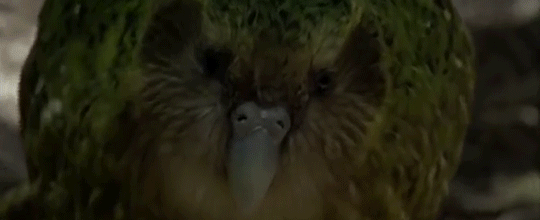
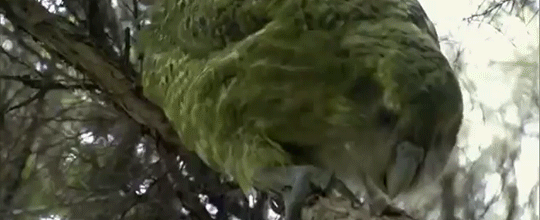

Kakapo were once the most successful and abundant herbivores in New Zealand.
BBC Earth
2K notes
·
View notes